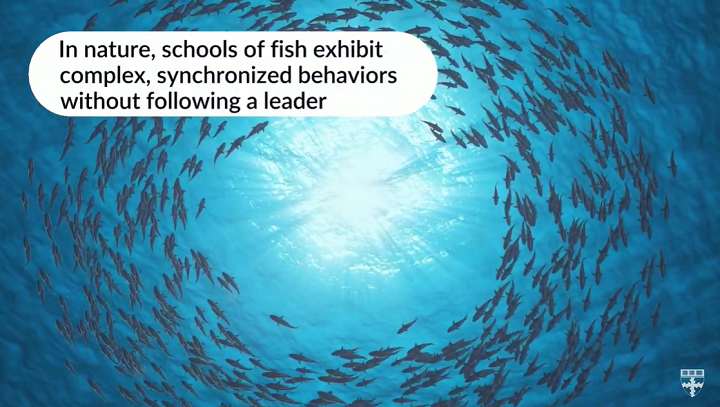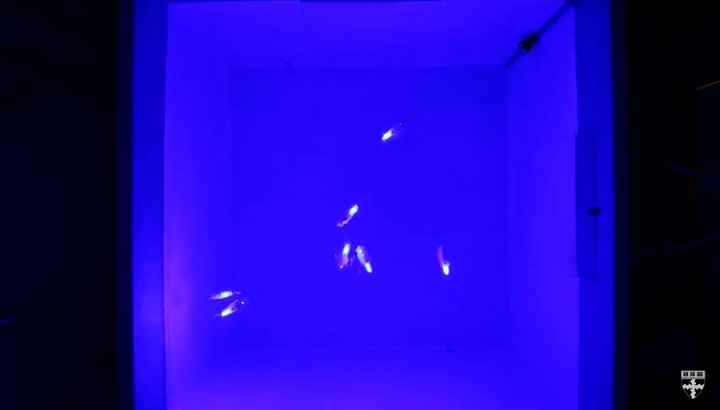We’ve seen 3D printed swarms of robots that are designed to pick up garbage, complete intricate production tasks, and even participate in surveillance, environmental, and search and rescue missions at sea. Now a team of researchers from the Harvard John A. Paulson School of Engineering and Applied Sciences (SEAS) and the Wyss Institute for Biologically Inspired Engineering have published a paper in Science Robotics about their work developing a swarm of 3D printed robotic fish that can autonomously coordinate their movements and swim just like a real school of fish, without any outside control.
The abstract states, “Many fish species gather by the thousands and swim in harmony with seemingly no effort. Large schools display a range of impressive collective behaviors, from simple shoaling to collective migration and from basic predator evasion to dynamic maneuvers such as bait balls and flash expansion. A wealth of experimental and theoretical work has shown that these complex three-dimensional (3D) behaviors can arise from visual observations of nearby neighbors, without explicit communication. By contrast, most underwater robot collectives rely on centralized, above-water, explicit communication and, as a result, exhibit limited coordination complexity. Here, we demonstrate 3D collective behaviors with a swarm of fish-inspired miniature underwater robots that use only implicit communication mediated through the production and sensing of blue light.’
Schools of fish, like the one seen above, migrate, find food, and escape from the jaws of predators through their use of complex, synchronized behaviors, which come from something called implicit coordination. Rather than a single fish coordinating the group’s movement, or several fish communicating with each other to decide the next move, this kind of decentralized, self-organization works by individual fish making their decisions based solely on what they see the other fish doing.
The research team’s fish-inspired robotic swarm, created in Professor Radhika Nagpal’s self-organizing systems lab, is named Blueswarm. According to a SEAS press release, this is the first time researchers have “demonstrated complex 3D collective behaviors with implicit coordination in underwater robots.”
“Our results with Blueswarm represent a significant milestone in the investigation of underwater self-organized collective behaviors. Insights from this research will help us develop future miniature underwater swarms that can perform environmental monitoring and search in visually-rich but fragile environments like coral reefs,” said Nagpal, the Fred Kavli Professor of Computer Science at SEAS and Associate Faculty Member at the Wyss Institute. “This research also paves a way to better understand fish schools, by synthetically recreating their behavior.”
There are seven 3D printed swimming robotic fish, or Bluebots, in the Blueswarm, and each one has two wide-angle cameras as eyes and three blue LEDs. By tracking the LED lights of the other Bluebots, each one reacts according to the cues they see with an onboard Raspberry Pi computer, in addition to a custom algorithm that can gauge heading, distance, and direction.
“Robots are often deployed in areas that are inaccessible or dangerous to humans, areas where human intervention might not even be possible. In these situations, it really benefits you to have a highly autonomous robot swarm that is self-sufficient,” explained Florian Berlinger, a PhD Candidate at SEAS and Wyss and first author of the paper. “By using implicit rules and 3D visual perception, we were able to create a system that has a high degree of autonomy and flexibility underwater where things like GPS and WiFi are not accessible.”
 These fish-inspired robots can synchronize their movements without any outside control. Based on the simple production and detection of LED light, the robotic collective exhibits complex self-organized behaviors, including aggregation, dispersion and circle formation. (Image courtesy of Self-organizing Systems Research Group)
These fish-inspired robots can synchronize their movements without any outside control. Based on the simple production and detection of LED light, the robotic collective exhibits complex self-organized behaviors, including aggregation, dispersion and circle formation. (Image courtesy of Self-organizing Systems Research Group)But while other robot swarms have been able to easily navigate in two-dimension spaces, three-dimensional ones, like water and air, are more difficult in terms of movement and sensing; that’s why the team created the onboard vision-based coordination system with LEDs and fish-lens cameras. With just their algorithm and production/detection of LED lights, the researchers showed that their Blueswarm was able to demonstrate complex, self-organized behavior, such as dispersion, circle formation, and aggregation.
“Each Bluebot implicitly reacts to its neighbors’ positions. So, if we want the robots to aggregate, then each Bluebot will calculate the position of each of its neighbors and move towards the center. If we want the robots to disperse, the Bluebots do the opposite,” Berlinger explained. “If we want them to swim as a school in a circle, they are programmed to follow lights directly in front of them in a clockwise direction.”
Additionally, the team tested their robotic fish with an easy simulated search mission in the tank, using just a red light. The Bluebots swam out across the tank using their dispersion algorithm, until one of them was close enough to the light to detect it, which prompted its LEDs to flash. This blue flashing caused the aggregation algorithm to kick in for the rest of the Blueswarm, and the other six gathered around the robotic fish with the flashing LED lights.
(Sources: Harvard SEAS and Gizmodo)
Subscribe to Our Email Newsletter
Stay up-to-date on all the latest news from the 3D printing industry and receive information and offers from third party vendors.
Print Services
Upload your 3D Models and get them printed quickly and efficiently.
You May Also Like
Heating Up: 3D Systems’ Scott Green Discusses 3D Printing’s Potential in the Data Center Industry
The relentless rise of NVIDIA, the steadily increasing pledges of major private and public investments in national infrastructure projects around the world, and the general cultural obsession with AI have...
3DPOD 260: John Hart on VulcanForms, MIT, Desktop Metal and More
John Hart is a Professor at MIT; he´s also the director of the Laboratory for Manufacturing and Productivity as well as the director of the Center for Advanced Production Technologies....
Etsy Design Rule Change Reduces Selection of 3D Printed Goods
Online marketplace Etsy has implemented a rule change requiring all 3D printed goods on the site to be original designs. The update to the site’s Creativity Standards states, ¨Items produced using...
E-Beam OEM Wayland Additive Partners with USC Racing to 3D Print Titanium Exhaust Collector
Every year, standards organization SAE International holds a competition called Formula SAE, in which students from both undergraduate and graduate programs design, build, and race small formula-style race cars. For...




































